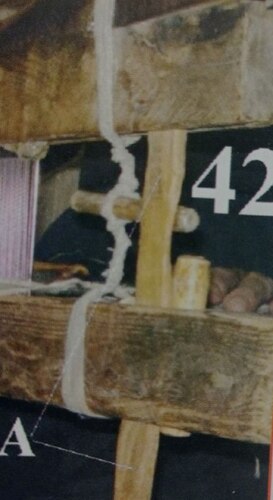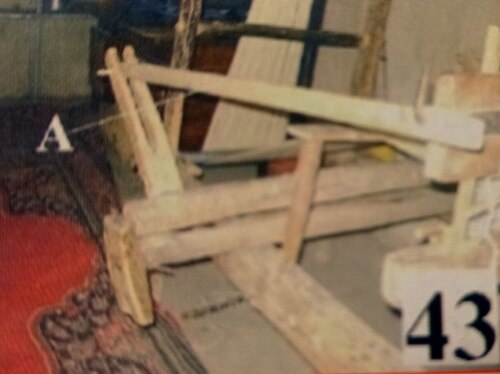Zherdaffa
It is a wide and long piece of log hung underneath the Zherdaffa with ropes. There are also two "Shilapa" on each side of the ropes to keep the Daffa and Zherdaffa straight in line. The ends of the "Shana" (comb) will fit into a gap between Daffa and Zherdaffa. When the ropes are tight, the Shana will stay still in its position and when the ropes are loosened, the Shana will move in the gap.
Sachin/ Sakin/ Sanchin/ Sakina
It is an L-shaped wooden tool to keep the Bangurd.
(See Figure 34)

Shaqol
It is a part of Lalangara that is attached to the spinning machine on both sides. One end of them will touch the Lalangara comb and the other end will be attached to a joint like part next to the Lalangara to keep the Daffa from the left and right sides.
(See figure 35)

Lalangara Shana
Two flat wooden tools with several jags fixed on each side of the Lalangara on the machine to keep the Lalangara nails in place on both sides. (See Figure 36)

Sometimes instead of that jagged wooden tool, the spinner uses some nails and they fix Lalangara between these nails. (See Figure 37)

Lalangara Shana is used to keep a suitable didtance between Daffa and the knitted fabric because if Daffa gets too close to the fabric it will not be knitted properly. Another part of Lalangara's importance is that if the Daffa began to stiffen Kiraka in an unstable way so that a part of the fabric came out very stiff and another part of it came out very loose, the only thing that could be done to fix this problem would be to change one side of Lalangara's position between the Shana. This will help Kiraka to be stiffened by the Daffa evenly.
Sha/ Shana
It is a wooden framework. The sides of it are made of hard logs and the top and bottom parts of it are made of "Berry" wood. The middle part of this framework is filled with comb like jags made of hard and strong leather. Berry wood is hard on the outside and soft on the inside. The jagged parts of the comb are screwed into the soft parts of the wood. Two threads of waft will pass through the comb's jags. The Shana is used to stiffen wraps' threads.
(See Figure 38, 39)


Shish
It is a narrow metal to be screwed into a pipe's hole. It is used to be fixed between to ends of Makoka. When Makoka is being used, the pipe will turn around Shish.
(See Figure 40, 41)


Shilapa/ Shirpa/ Shirpe/ Gwedaffa
These are two pieces of strong and narrow logs to be stuffed into Daffa and Zherdaffa on each side to keep them connected. There are two strong and thick pieces of threads on the sides of Shilapa that are wrapped around a piece of wood to keep Daffa and Zherdaffa fixed firmly. In order to prevent the logs from getting loosened, they are attached to Shilapa.
(See Figure 42)

Qol
It is a part of Lalangara that consists of two wide and long logs to connect Daffa and Shaqol on the left and right sides of the machine. Qol is used to keep Daffa straight and prevent it from falling to the left or right side and keep it working straight. (See Figure 43)

Karkhana
Two parts made in a way that a person can sit on it in a way that their feet can touch the ground. It is attached to two walls across each other. All the parts of the spinning machine are fixed on these two parts. (See Figure 44)

Nanawa Karkhana
This Karkhana includes a framework with wooden nails screwed into it on each end. It is used to fold Barmal (a piece of fabric for Muslims to pray on it) and Jajm (a kind of fabric in large sizes). (See Figure 45)


Some of the wooden nails are not screwed firmly and they can be moved. (See Figure 47)
These moveable nails can be taken out and become "Tirounda" to be tied on the spinning machine.

Kursi
Two pieces of large logs that are fixed on the Karkhana base. They are kept near the wall. Some pieces of "Doshagala" (a soft part of the rug) are put on it for the spinner to sit.
(See Figure 48)









